download the PDF here - Amphibian Specialist Group
download the PDF here - Amphibian Specialist Group
download the PDF here - Amphibian Specialist Group
You also want an ePaper? Increase the reach of your titles
YUMPU automatically turns print PDFs into web optimized ePapers that Google loves.
These new discoveries bring <strong>the</strong> number of new species described<br />
by herpetologist SD Biju and his colleagues to an astounding<br />
forty-five. Among <strong>the</strong> new species described, is <strong>the</strong> “Deven’s<br />
Golden Night Frog” (Nyctibatrachus deveni), which is restricted<br />
to a small area of forest within <strong>the</strong> Indian state of Kerala. This<br />
frog is named after Deven Brian Sheth, in honor of his wildlife<br />
philanthropic parents, Adria Sheth and Brian Sheth, who is<br />
President of Vista Equity Partners, a private equity firm focused<br />
on software and technology-enabled businesses.<br />
Previous discoveries include <strong>the</strong> famed “Purple Frog”<br />
(Nasikabatrachus sahyadrensis) belonging to a new family<br />
of frogs, Nasikabatrachidae; <strong>the</strong> diminutive Nyctibatrachus<br />
minimus, <strong>the</strong> smallest tetrapod in India; <strong>the</strong> first Indian canopy<br />
frog, Raorchestes nerostagona, and <strong>the</strong> first Asian leaf folding<br />
frog Rhacophorus lateralis, among o<strong>the</strong>rs.<br />
Frogs are environmental barometers and are very sensitive<br />
to subtle changes in <strong>the</strong>ir environment. They lived alongside<br />
dinosaurs, which have long since disappeared, but amazingly frogs<br />
continue to exist. Unfortunately, <strong>the</strong>ir existence is precarious.<br />
If <strong>the</strong> present trends in extinction continue, many frogs could<br />
disappear forever. Thirty-two percent of <strong>the</strong> world’s amphibian<br />
species are threatened with extinction. Every twenty minutes<br />
a species is pushed to extinction and more than 1000 acres of<br />
forests are destroyed. But <strong>the</strong>re is still a small ray of hope for a<br />
brighter future for frogs. To begin, <strong>the</strong>y have lived on earth for a<br />
period that is 5000 times longer than that of humans. Also, <strong>the</strong>re<br />
is a rapidly growing interest in frogs among scientists and nature<br />
lovers alike.<br />
“<strong>Amphibian</strong>s are popularly known as environmental barometers.<br />
They indicate <strong>the</strong> state of environmental health. Their<br />
conservation is extremely vital not only from amphibians point of<br />
view but also from <strong>the</strong> perspective of overall nature conservation”<br />
explains Delhi University Professor S D Biju, who led <strong>the</strong> research.<br />
Six out of <strong>the</strong> twelve new species are from unprotected, highly<br />
degraded habitats and require immediate attention to conserve<br />
<strong>the</strong>se species and <strong>the</strong>ir habitats. The night frogs require unique<br />
habitats - ei<strong>the</strong>r fast flowing streams or moist forest floor for<br />
breeding and survival. Fur<strong>the</strong>r, it is <strong>the</strong> only group of frogs that<br />
can achieve fertilization and reproduction without any physical<br />
contact. This paper also reported <strong>the</strong> reproductive strategy in six<br />
species, and provided evidence for parental care behavior.<br />
“The major threat to amphibians in India is massive habitat loss.<br />
Taking any conservation effort for amphibians will indirectly<br />
conserve several o<strong>the</strong>r important biodiversities of that area” SD<br />
Biju.<br />
Financial support for field and lab studies:<br />
Department of Biotechnology, Government of India<br />
Ministry of Environment and Forests, Government of India.<br />
University of Delhi (support to faculty for streng<strong>the</strong>ning R & D<br />
program)<br />
“Lost” frogs found! from left to right: KEMPHOLEY NIGHT FROG - Nyctibatrachus<br />
kempholeyensis, COORG NIGHT FROG - Nyctibatrachus sanctipalustris,<br />
FOREST NIGHT FROG - Nyctibatrachus sylvaticus. Photo: S.D. Biju<br />
Fur<strong>the</strong>r information contact:<br />
S.D. Biju Systematics Lab www.frogindia.org Department<br />
of Environmental Biology, University of Delhi 110 007, India.<br />
Email: sdbiju.du@gmail.com<br />
Don Church, Global Wildlife Conservation, Austin, Texas, USA.<br />
www.globalwildlife.org Email: dchurch@globalwildlife.org<br />
Robin Moore, IUCN/SSC <strong>Amphibian</strong> <strong>Specialist</strong> <strong>Group</strong>, Arlington,<br />
VA, USA. Email: rdmoore@conservation.org<br />
FrogLog Vol. 98 | September 2011 | 23
















